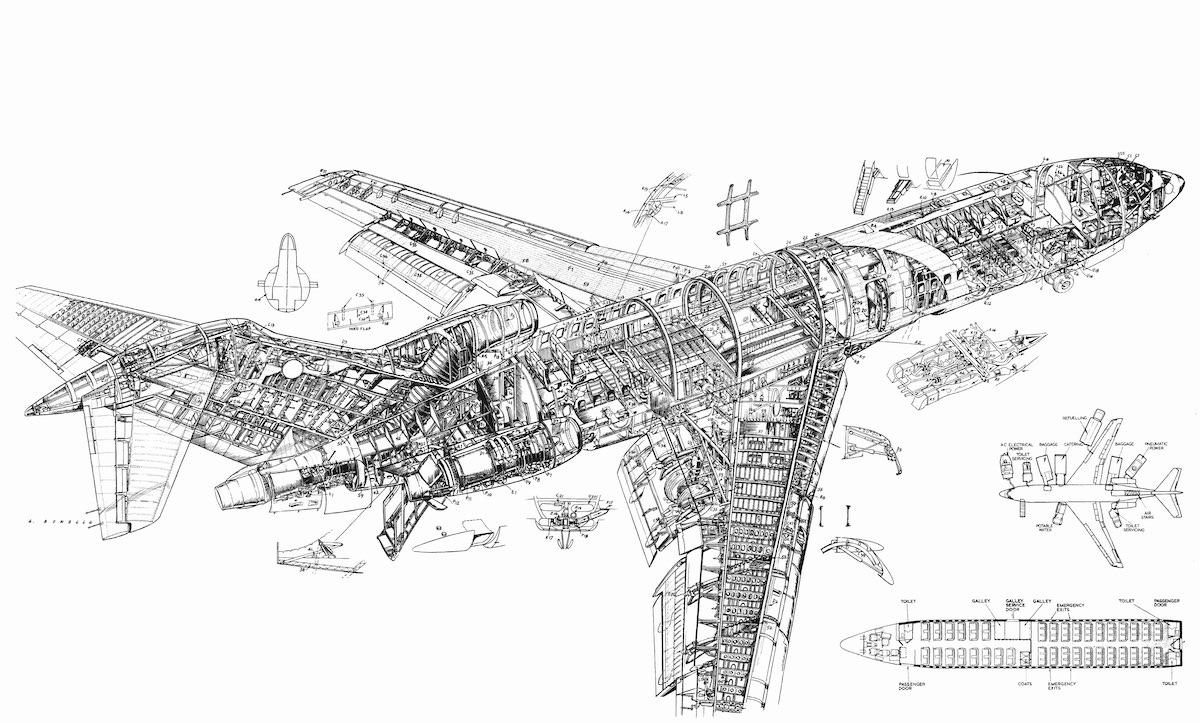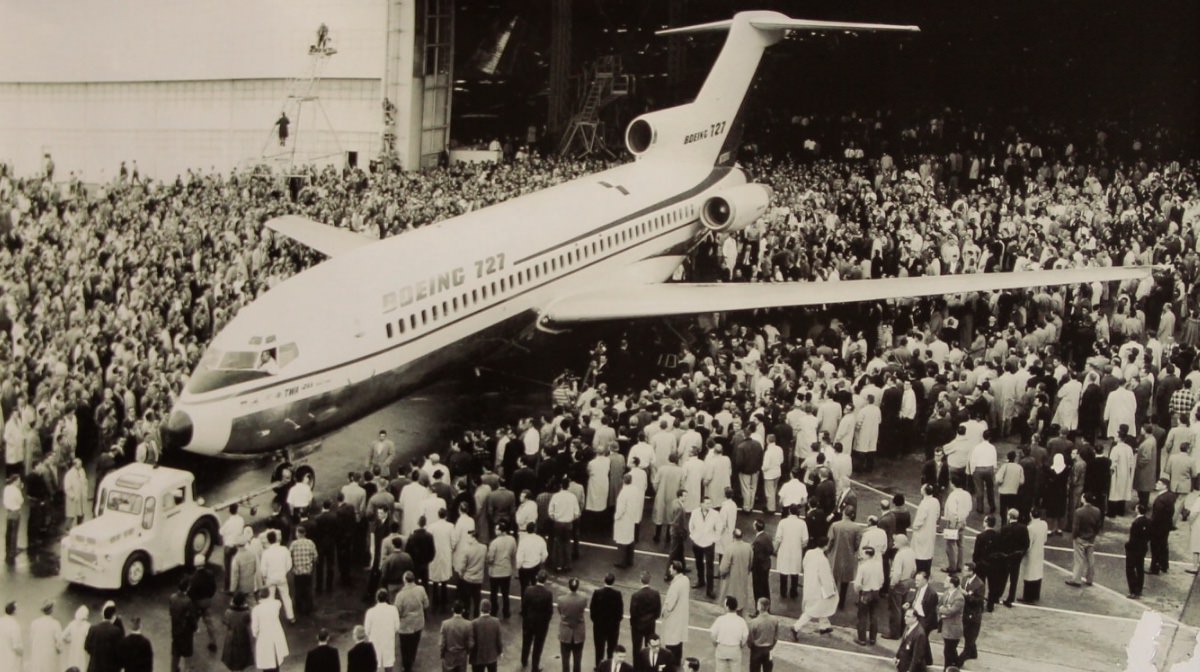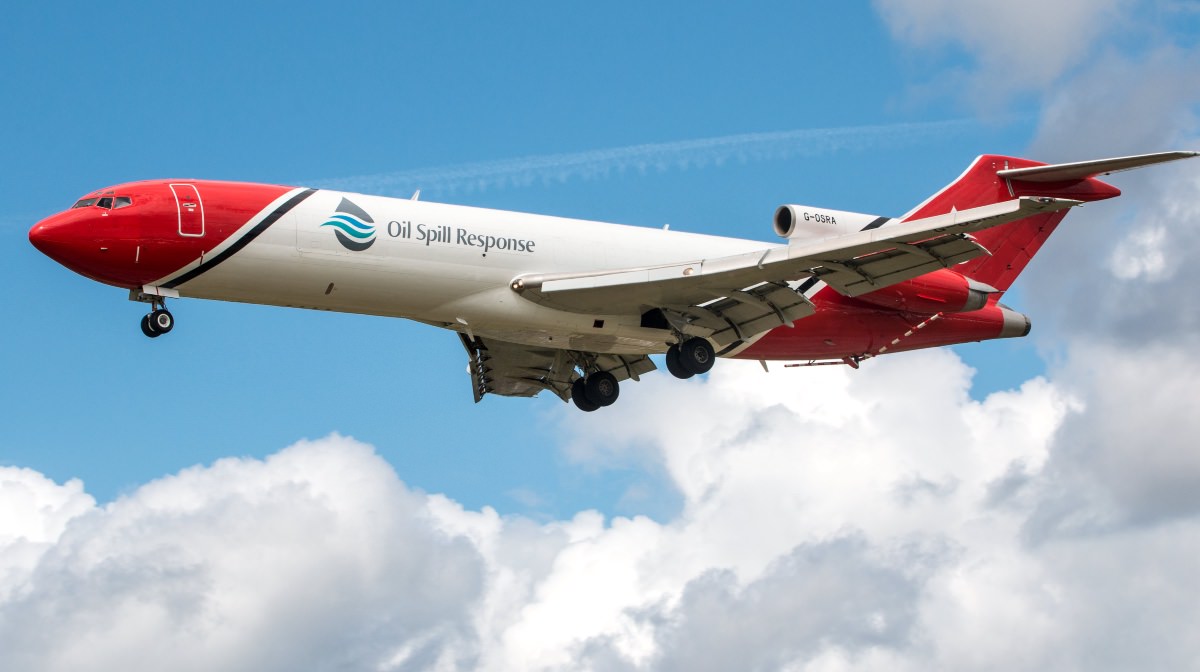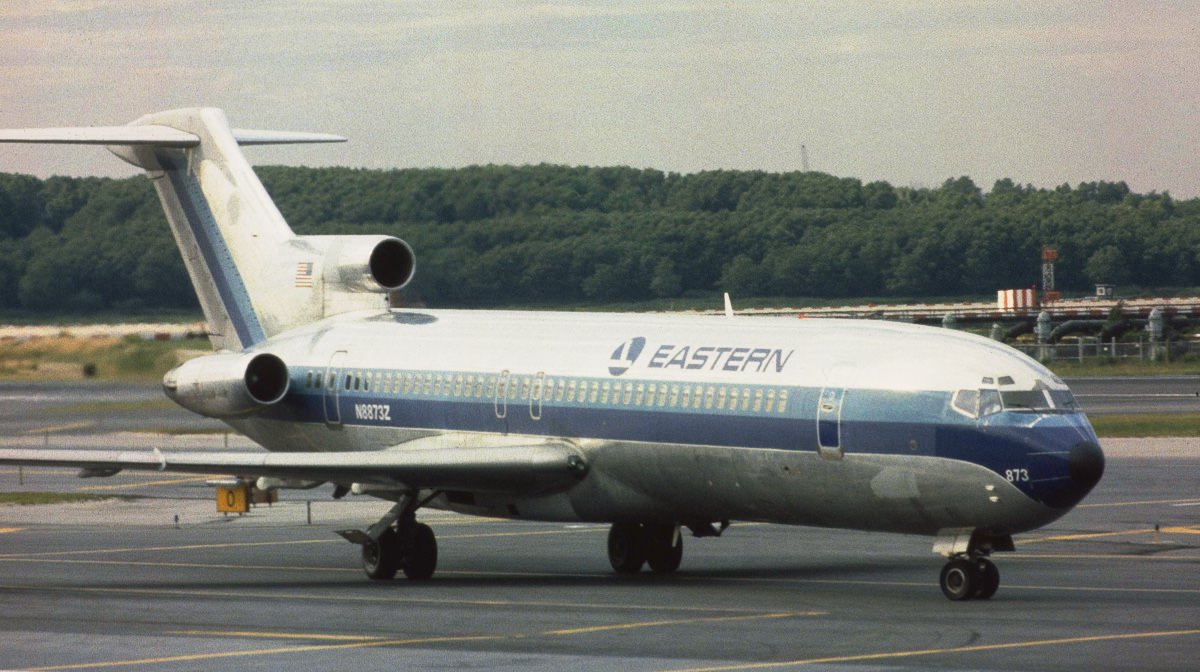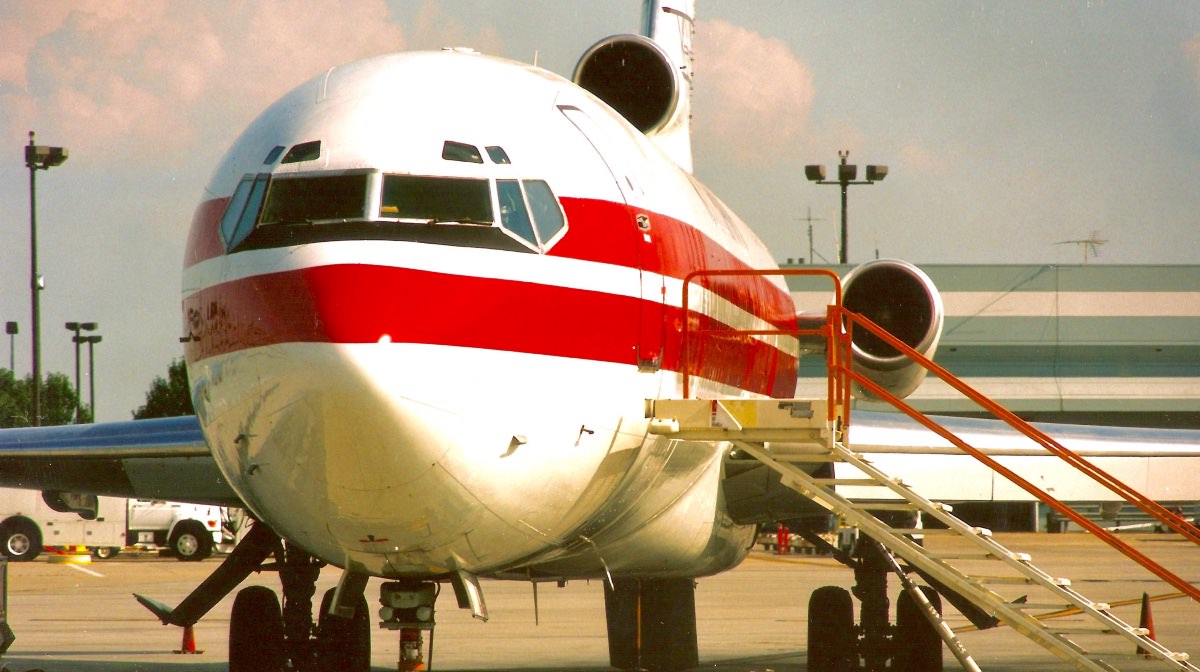Price: $29.95
- 1 magazine, 12 manuals, & photos
- PDF contains 12,541 pages
- Content is keyword searchable
- Print a personal copy
- Pay via PayPal or Credit Card
- International orders welcome!
- Download files upon payment
September 2004
- North American’s Incredible XF-108!
- Factory Fresh – Lockheed Vega
- Itazuke Air Base ramp tour
- X-5 to F-14 Swing-Wings – We unlock the secrets of variable geometry!
Manuals & Photos
- B-727 Flight Crew Training Manual, 1985
- B-727 Operating Manual, Vol 1., 2016
- B-727 TWA Taxi Handbook, 1973
- B-727 Operations Manual, 1972
- B-727 Performance Handbook, 2011
- B-727 DC9 APU Troubleshooting, 1974
- B-727 Maintenance Manual, 2000
- B-727 Northwest Airline Maintenance Training
- B-727 Facility Planning, 1975
- B-727 Airport Planning, 1985
- B-727 Boeing Executive Brochure, 1963
- B-727 Master Minimum Equipment List, 2017
- Over 390 Photos
Boeing 727
Specs
Variants
On Display
Cutaway
Videos
| Variant | 727-100 | 727-200 | 727-200 Advanced |
|---|---|---|---|
| Wingspan | 108 ft (32.92 m) | ||
| Wing | 1,650 sq ft (153 m2), 32° sweep | ||
| Two-class seats | 106: 16F at 38 in, 90Y at 34 in | 134: 20F at 38 in, 114Y at 34 in | |
| Thrust ×3 | 14,000–14,500 lbf (62–64 kN) | 14,000–15,000 lbf (62–67 kN) | 14,500–17,400 lbf (64–77 kN) |
| Take-off | 8,300 ft (2,500 m) | 8,400 ft (2,600 m) | 10,100 ft (3,100 m) |
| Range | 2,250 nmi (4,170 km; 2,590 mi) | 1,900 nmi (3,500 km; 2,200 mi) | 2,550 nmi (4,720 km; 2,930 mi) |
| One-class seats | 125 at 34 in | 155 at 34 in | |
| OEW | 87,696 lb (39,800 kg) | 97,650 lb (44,330 kg) | 100,700 lb (45,720 kg) |
| MTOW | 169,000 lb (76,700 kg) | 172,000 lb (78,100 kg) | 209,500 lb (95,100 kg) |
| MMO | Mach 0.9 (519 kn; 961 km/h; 597 mph) at 35,000 ft (11,000 m) | ||
| Length | 133 ft 2 in (40.59 m) | 153 ft 2 in (46.68 m) | |
| Height | 34 ft 3 in (10.44 m) | 34 ft 11 in (10.65 m) | |
| Fuel capacity | 7,680 US gal (29,069 L) | 8,090 US gal (30,620 L) | 10,585 US gal (40,060 L) |
| Flight crew | Three | ||
| Exit limit | 131 | 189 | |
| Engines ×3 | Pratt & Whitney JT8D-1/7/9 | JT8D-7/9/11 | JT8D-9/15/17/17R |
| Cruise | 495–518 kn (917–960 km/h; 570–596 mph) | 467–515 kn (865–953 km/h; 537–593 mph) | |
| Ceiling | 42,000 ft (13,000 m) | ||
| Cabin width | 140 in (3.56 m) | ||
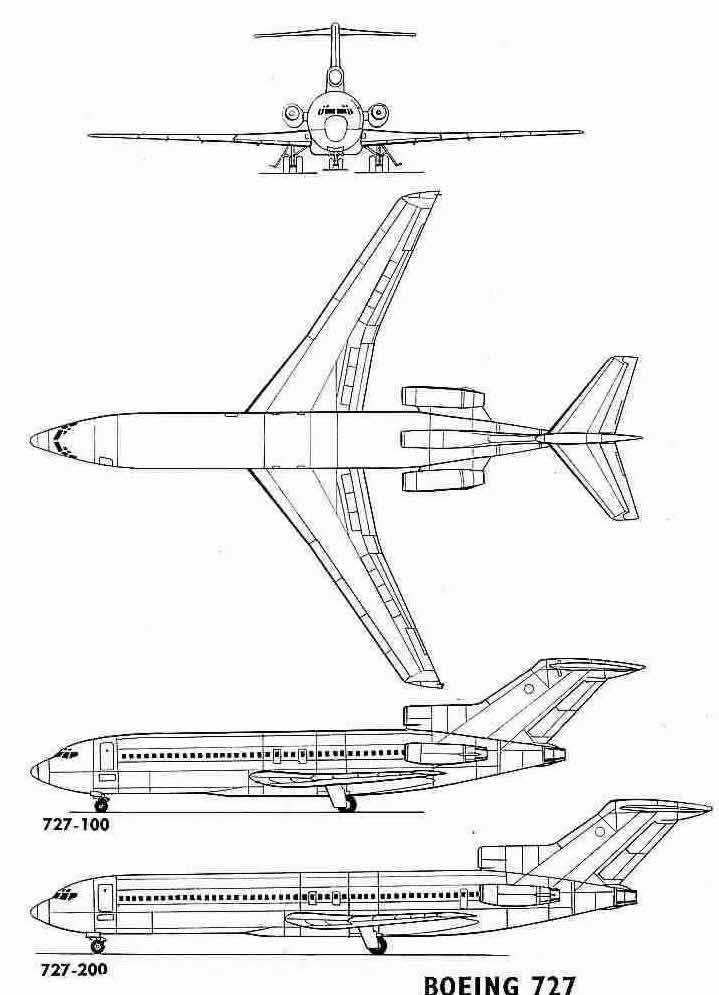 The two series of 727 are the initial -100 (originally only two figures as in -30), which was launched in 1960 and entered service in February 1964, and the -200 series, which was launched in 1965 and entered service in December 1967.
The two series of 727 are the initial -100 (originally only two figures as in -30), which was launched in 1960 and entered service in February 1964, and the -200 series, which was launched in 1965 and entered service in December 1967.
727-100
The first 727-100 (N7001U) flew on February 9, 1963. FAA type approval was awarded on December 24 of that year, with initial delivery to United Airlines on October 29, 1963, to allow pilot training to commence. The first 727 passenger service was flown by Eastern Air Lines on February 1, 1964, between Miami, Washington, DC, and Philadelphia.
A total of 571 Boeing 727-00/100 series aircraft were delivered (407 -100s, 53 -100Cs, and 111 -100QCs), the last in October 1972. One 727-100 was retained by Boeing, bringing total production to 572.
The -100 designation was assigned retroactively to distinguish the original short-body version. Actual aircraft followed a “727-00” pattern. Aircraft were delivered for United Airlines as 727-22, for American Airlines as 727-23, and so on (not -122, -123, etc.) and these designations were retained even after the advent of the 727-200.
- 727-100C
Convertible passenger cargo version, additional freight door and strengthened floor and floor beams, three alternative fits:
- 94 mixed-class passengers
- 52 mixed-class passengers and four cargo pallets (22,700 lb or 10,300 kg)
- Eight cargo pallets (38,000 lb or 17,000 kg)
- 727-100QC
QC stands for Quick Change. This is similar to the convertible version with a roller-bearing floor for palletised galley and seating and cargo to allow a much faster changeover time of 30 minutes.
- 727-100QF
QF stands for Quiet Freighter. A cargo conversion for United Parcel Service, these were re-engined with Stage 3-compliant Rolls-Royce Tay turbofans.
- Boeing C-22A
- A single 727-30 acquired from the Federal Aviation Administration, this aircraft was originally delivered to Lufthansa. It served mostly with United States Southern Command flying from Panama City / Howard Air Force Base.
- Boeing C-22B
- Four 727-35 aircraft were acquired from National Airlines by the United States Air Force for transporting Air National Guard and National Guard personnel.
727-200
A stretched version of the 727-100, the -200 is 20 feet (6.1 m) longer (153 feet 2 inches or 46.69 metres) than the -100 (133 feet 2 inches or 40.59 metres). A 10 ft (3.0 m) fuselage section (“plug”) was added in front of the wings and another 10 ft fuselage section was added behind them. The wing span and height remain the same on both the -100 and -200 (108 and 34 feet (33 and 10 m), respectively). The original 727-200 had the same maximum gross weight as the 727-100; however, as the aircraft evolved, a series of higher gross weights and more powerful engines were introduced along with other improvements, and from line number 881, 727-200s are dubbed -200 Advanced. The aircraft gross weight eventually increased from 169,000 to 209,500 pounds (76,700 to 95,000 kg) for the latest versions. The dorsal intake of the number-two engine was also redesigned to be round in shape, rather than oval as it was on the -100 series.
The first 727-200 flew on July 27, 1967, and received FAA certification on November 30, 1967. The first delivery was made on December 14, 1967, to Northeast Airlines. A total of 310 727-200s were delivered before the -200 was replaced on the production line by the 727-200 Advanced in 1972.
- 727-200C
A convertible passenger cargo version; only one was built.
- 727-200 Advanced
The Advanced version of the 727-200 was introduced in 1970.[45] It featured powerful engines, fuel capacity and MTOW (185,800–210,000 lb or 84.3–95.3 t) increased the range from 1,930 to 2,550 nmi (3,570 to 4,720 km; 2,220 to 2,930 mi) or by 32%.[46] After the first delivery in mid-1972, Boeing eventually raised production to more than a hundred per year to meet demand by the late 1970s. Of the passenger model of the 727-200 Advanced, a total of 935 were delivered, after which it had to give way to a new generation of aircraft.
- 727-200F Advanced
A freighter version of the 727-200 Advanced became available in 1981, designated the Series 200F Advanced. Powered by Pratt & Whitney JT8D-17A engines, it featured a strengthened fuselage structure, an 11 ft 2 in (3.40 m) by 7 ft 2 in (2.18 m) forward main deck freight door, and a windowless cabin. Fifteen of these aircraft were built, all for Federal Express. This was the last production variant of the 727 to be developed by Boeing; the last 727 aircraft completed by Boeing was a 727-200F Advanced.
- Super 27
Certificated by Valsan Partners in December 1988 and marketed by Goodrich from 1997, the side engines are replaced by more efficient, quieter JT8D-217C/219, and the center engine gains a hush kit for $8.6 million (but loses the thrust reverser) (2000): fuel consumption is reduced by 10-12%, range and restricted airfield performance are improved.
- Boeing C-22C
A single 727-212 aircraft was operated by the USAF.
Proposed
- 727-300
A proposed 169-seat version was developed in consultation with United Airlines in 1972, which initially expressed an interest in ordering 50 aircraft. Also, interest was shown from Indian Airlines for a one-class version with 180 seats. The fuselage would have been lengthened by 18 feet (5.5 m) and the undercarriage strengthened. The three engines would have been replaced by two more powerful JT8D-217 engines under the T tail. Many cockpit components would have been in common with the 737-200 and improved engine management systems would have eliminated the need for the flight engineer. United did not proceed with its order and Indian Airlines instead ordered the larger Airbus A300, so the project was cancelled in 1976.
- 727-400
A concept with a 155-foot (47 m) fuselage and two high-bypass turbofan engines under the wings (but retaining the T tail) was proposed in 1977. More compact systems, a redesign of the internal space, and removing the need for the flight engineer would have increased the capacity to 189 seats in a two-class configuration. After only a few months, the concept was developed into the Boeing 7N7 design, which eventually became the Boeing 757.
Other variants
Faw-727
This Boeing 727 was reportedly modified by Iraq in early 1988 to serve as an ELINT platform. It was used during the invasion of Kuwait and Operation Desert Shield.
A large number of surviving retired 727s remain, largely as a result of donation by FedEx of 84 of them to various institutions. The vast majority of the aircraft was given to university aviation maintenance programs. All but five are located within the United States. Notable aircraft include:
- N7001U – 727-022 is on static display at the Museum of Flight in Seattle, Washington. It was the first 727 completed. It departed from Paine Field in Everett, Washington, and landed at the museum on March 2, 2016.
- N7004U – 727-022 is in storage at the Pima Air & Space Museum in Tucson, Arizona. It was the first 727 delivered to a customer and the first to make a commercial flight.
- N7017U – 727 is on static display at the Museum of Science and Industry in Chicago, Illinois. It was donated by United Airlines. It features cutaway sections showing airplane framework and lavatory, cockpit view, and a few rows of seating.
- N166FE Bud – 727-100F is on static display at Musée de l’air et de l’espace in Le Bourget, France. It was formerly operated by FedEx and donated to the museum in 2007.
- N186FE – 727-100 is on static display at Owens Community College in Perrysburg, Ohio. It formerly was operated by FedEx and donated by the company in 2007.
- N199FE – 727-173C is on static display at the Kansas Aviation Museum in Wichita, Kansas. It was formerly operated by FedEx as N199FE.
- N113FE Jarrod – 727-022C is in storage at the National Museum of Commercial Aviation in Atlanta, Georgia. It was formerly operated by FedEx as N113FE, and by United Airlines before that as N7437U.
- N265FE Paul – 727-200 is on static display at the Florida Air Museum in Lakeland, Florida. It was formerly operated by FedEx.
- N492FE Two Bears – 727-227 is on static display at FLY8MA in Big Lake, Alaska. It was transported from Anchorage, Alaska to The FLY8MA Pilot Lodge in April 2023, and converted into an airplane home.
- N874AA – 727-223 was previously on display at the Museum of Flight and later stored for the Airline History Museum at Boeing Field in Seattle. The aircraft was eventually seized by King County, Washington for nonpayment of rent and storage fees, declared nonairworthy, and scrapped at Boeing Field in November 2021.
- N211DB – 727-2J4 forward fuselage is reused as a commercial aviation set and on display at EECity, an experience facility for children located in Beijing, China. It was formally operated by Sky One Express Airlines before retirement.
- G-BNNI Lady Patricia – 727-276 was last flown by Sabre Airways in 2000. Purchased by 727 Communications, an advertising company in Skanderborg, Denmark, it now serves as a conference room and billboard at their offices.
- VP-CMN “PYTCHAir” – 727-46 is located in Bristol, UK, and was purchased by technology investor Johnny Palmer for his media company PYTCH. The fuselage is resting atop a series of shipping containers and was transported in February 2021.
- XA-RRA – 727-14, last operated by Taesa is located in Mexicana de Aviación livery at Parque Metropolitano in León, Guanajuato, Mexico.
- XC-FPA – 727-264/Adv, last operated by the Mexican Federal Police, is on display in Parque Tangamanga, San Luis Potosí City, Mexico.
- A nose section of a 727 is on static display at the Museum of Flying in Santa Monica, California; it was donated by FedEx after retirement, and underwent a complete restoration in the fall of 2018.
- N149FE, a 727-22 (S/N 19807) manufactured in 1967, is on static display at Guilford Technical Community College (GTCC) in Greensboro, North Carolina. It was formerly used by the FedEx Express before being donated to TIMCO (now HAECO) as a maintenance training aid before being donated to Guilford Technical Community College for use as a training aid for their Aircraft maintenance technician program.
- SX-CBA, the first Boeing 727 delivered for Olympic Airways, is preserved at the Sourmena Stadium in Elliniko.
